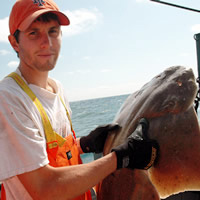Best Student Paper Awards
Each year a committee of faculty and students undertakes the difficult task of choosing the best journal articles from the many high-quality papers written by VIMS graduate students. Each paper considered is either accepted, in press, or published in a high-quality, peer-reviewed journal. The papers reflect the superb quality of the research conducted by VIMS students and the outstanding mentoring of their advisors. Papers are judged for the scope of problem, degree of challenge, magnitude of student’s effort, hypothesis formulation and testing, and writing style.
The committee, which included Richard Brill, Ryan Carnegie, Allison Colden, Jerome Maa, and Kam Tang, evaluated 15 papers in both the Ph.D. and Master’s categories.
Master's
This year’s choice for the best
paper by a Master’s student goes to Sarah
Sumoski for “Biotic Dispersal in eelgrass Zostera marina.” Her paper appeared in Marine Ecology Progress Series and was co-authored by Robert Orth. Sarah’s
paper was chosen for the featured articled in their December issue and was
published just 6 months after she formally graduated from VIMS.
Sarah is currently working as a research scientist in Dr. Orth’s lab. She was one of the first people to address the role that vertebrates play in dispersing seagrass seeds, a process well known among land plants, yet almost completely unknown in seagrasses. She conclusively proved after 3 years of painstaking feeding trials that an eelgrass seed can make it through the gut of different animal species, and germinate. She also determined that these animals could transport seeds as far as currents carry flowering shoots with seeds. This research will be highly cited in future years given the importance of seed dispersal in maintaining or establishing viable populations of seagrasses.
Congratulations, Sarah!
Ph.D.
The most meritorious student
author in the PhD category is Patrick
Lynch for his paper “Performance of methods used to estimate indices of
abundance for highly migratory species.” This paper appeared in Fisheries Research and was co-authored
by Kyle Shertzer and Rob Latour.
The accuracy of stock assessments used to evaluate the status of highly migratory fishes depends, in part, on developing indices of relative abundance. Two competing approaches have historically been used for this purpose, and the literature is rich with the pros and cons of each approach. As an attempt to bring some closure to the controversy, Patrick evaluated the performance of both methods, along with a new hybrid approach he developed independently. The results of Patrick’s study showed that his hybrid approach convincingly outperformed both of the other methods, and we are hopeful that Patrick’s approach will be adopted by U.S. and international scientists working on assessments of highly migratory species.
Congratulations, Patrick!

